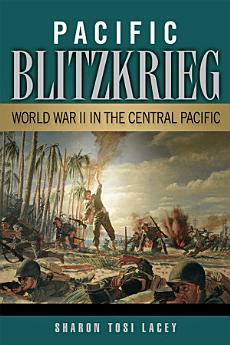Pacific Blitzkrieg: World War II in the Central Pacific
About this ebook
Pacific Blitzkrieg closely examines the planning,
preparation, and execution of ground operations for five major invasions in the
Central Pacific (Guadalcanal, Tarawa, the Marshalls, Saipan, and Okinawa). The
commanders on the ground had to integrate the U.S. Army and Marine Corps into a
single striking force, something that would have been difficult in peacetime,
but in the midst of a great global war, it was a monumental task. Yet, ultimate
success in the Pacific rested on this crucial, if somewhat strained,
partnership and its accomplishments. Despite the thousands of works covering
almost every aspect of World War II in the Pacific, until now no one has
examined the detailed mechanics behind this transformation at the corps and
division level.
Sharon Tosi Lacey makes extensive use of previously untapped primary
research material to re-examine the development of joint ground operations, the
rapid transformation of tactics and equipment, and the evolution of command
relationships between army and marine leadership. This joint venture was the
result of difficult and patient work by commanders and evolving staffs who
acted upon the lessons of each engagement with remarkable speed. For every
brilliant strategic and operational decision of the war, there were thousands
of minute actions and adaptations that made such brilliance possible.
Lacey
examines the Smith vs. Smith controversy during the Saipan invasion using newly
discovered primary source material. Saipan was not the first time General
“Howlin’ Mad” Smith had created friction. Lacey reveals how Smith’s blatant
partisanship and inability to get along with others nearly brought the American
march across the Pacific to a halt.
Pacific Blitzkrieg explores the combat
in each invasion to show how the battles were planned, how raw recruits were
turned into efficient combat forces, how battle doctrine was created on the
fly, and how every service remade itself as new and more deadly weapons
continuously changed the character of the war. This book will be a must read
for anyone who wants to get a behind-the-scenes story of the victory.
“Pacific Blitzkrieg is not only a major contribution to our
understanding of the Pacific War, but is also a delight to read. Lacey
demolishes the belief, widely held among students of the Pacific War, that a
deep gulf lay between the Marine Corps and the Army. In every respect Pacific Blitzkrieg is what one should
expect from a scholarly book: well researched, well argued, and coherent.”—Williamson Murray, coauthor of A War to Be Won: Fighting the Second World
War
“This is a
significantly fresh approach in that it goes beyond the Army-Marine
controversies best exemplified by ‘Smith versus Smith.’ It does so by
explaining their genesis in institutional and personal terms, then showing how
both services marginalized the controversies during the war, in the interest of
resolving the real problem: crossing the central Pacific with minimum
cost and maximum effectiveness.”—Dennis
E. Showalter, author of Hitler’s
Panzers and Patton and Rommel
“Pacific Blitzkrieg is an exceptional analysis of U.S. joint
amphibious operations against Japan during World War II. Lacey clearly
demonstrates that despite the heat of the Smith versus Smith controversy during
the invasion of Saipan, in fact U.S. Army and Marine units and commanders
cooperated far better than the published historical record to date suggests. A
must read for current and future joint force commanders and their staffs.”—Peter R. Mansoor, author of The GI Offensive in Europe: The Triumph of
American Infantry Divisions, 1941-1945
Ratings and reviews
- Flag inappropriate
About the author
SHARON TOSI LACEY earned her Ph.D. in military history from the University of Leeds, and is also a graduate of the United States Military Academy and Long Island University. She has served as a U.S. Army officer for more than 22 years and published more than 30 articles on military issues in magazines and journals. She currently lives in Northern Virginia with her husband and four children.
